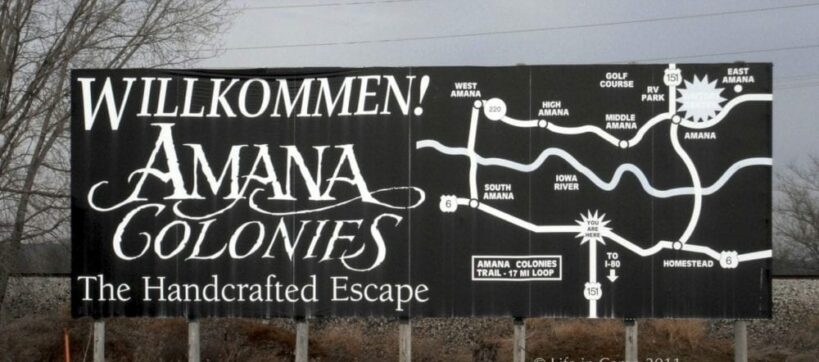Blog
The Seven Villages of the Amana Colonies

There are SEVEN villages of the Amana Colonies
There is a lot more to see in the seven villages of the Amana Colonies than you might think. It's easy to make a quick stop in Amana and completely miss out on the treasures of the other six smaller villages.
Homestead
Homestead, where we live, is the only village without “Amana” in its name. That’s because it was already a little village when the Amana folks came in the 1850s. They purchased Homestead because the railroad went through here and that was crucial in shipping their goods in and out, from back east. Today, there are three places of lodging, including us—Die Heimat Country Inn, pictured here. There is also the Troy Thomas Art Gallery, the Homestead Church, which is part of the museum system, and about 150 inhabitants along one main street. Talk about quiet!
South Amana
Five miles to the west is South Amana, where Schanz Furniture and Refinishing is located. Amana is known for its quality craftsmanship and furniture making. The furniture is gorgeous and each piece is still made exclusively by one artisan—no assembly lines here!
South Amana is also home to the famous Fern Hill Gifts and Quilts. My, oh my, the fabrics they carry! Over 4,000 bolts for quilters including the famous “Frond Designs” where artist Stephanie Brandenburg turns her hand-painted art into beautiful fabric. Quilters go nuts in this store. They also have antiques, gifts, jewelry, fudge and a little corner where you can get a piece of pie should you be with someone not as enthralled with quilting as you! South Amana is also home to the Mini-Americana Barn Museum (wonderful wood-carved miniatures).
At South Amana, you make a turn north and head a few miles to West Amana.
Local water color artist, Michelle Maring Miller has renovated the Old West Church into her home and main studio. Look for her "open" sign to take a peak at her lovely paintings.
High Amana
High Amana is located just two miles east of West Amana. High Amana is home to the High Amana General Store and the Arts Guild where local artisans work is on display and for sale.
The Arts Guild showcases historic Amana folk arts and proclaims “everything handmade in the Amana Colonies”. The Arts Guild also offers a series of intensive weeklong and weekend Art Iowa Workshops for college graduate credit or just for personal enrichment.
The guild also sponsors several summer events; the Arts Festival and Woodfest.
They have moved their sales room to main Amana to a storefront called "Gallery on Main".
Middle Amana
A few more miles down the road and you are in Middle Amana. You’ll notice the large Whirlpool campus off to the right. They still make Amana Refrigerators and hire around 4,000 people right here in this tiny rural area. The Amana refrigerators were originally made by George Forstner, an Amana native, but more recently the company has been owned by Maytag and now Whirlpool.


East Amana
Heading east, we are back in Amana and then another three miles south back to Homestead. But that’s only six villages! Where is the seventh? East Amana is outside the loop and one mile east of Amana. There are no commercial stores here. Instead, you’ll find a lovely picturesque little village of homes. I think the view from the cemetery looking down across the Amana village and valley is one of the prettiest in the area. It’s definitely worth a stop.
Conclusion
Visitors can travel from village to village and tour the colonies on their own by watching for the black and white signs that mark the shops, museums, artists, and wineries. But I suggest you start with an organized tour. Village Voyage Tours leave from the Amana Visitor’s Center at 11:00am and 2:00pm each day Monday-Saturday during the main season of May-October. You’ll travel in the comfort of the Amana mini-bus with a knowledgeable and entertaining guide giving you the inside stories of the past as well as insight into the culture and customs of today.
You’ll visit the museum and watch the award winning video about the history of the Colonies. You’ll visit several of the seven villages; visit a church where you’ll hear about the beliefs and simple faith of the Inspirationists. You'll step back in time to when Amana was communal and visit a kitchen where villagers partook of three hearty meals a day plus two snacks prepared under the careful eye of the "kitchen boss" and her staff.
As you drive along, you will notice the beauty of the landscape, the lily lake, the flower gardens, the unique historic structures, as well as the friendly locals who are happy to welcome you and to share stories of this special place.




